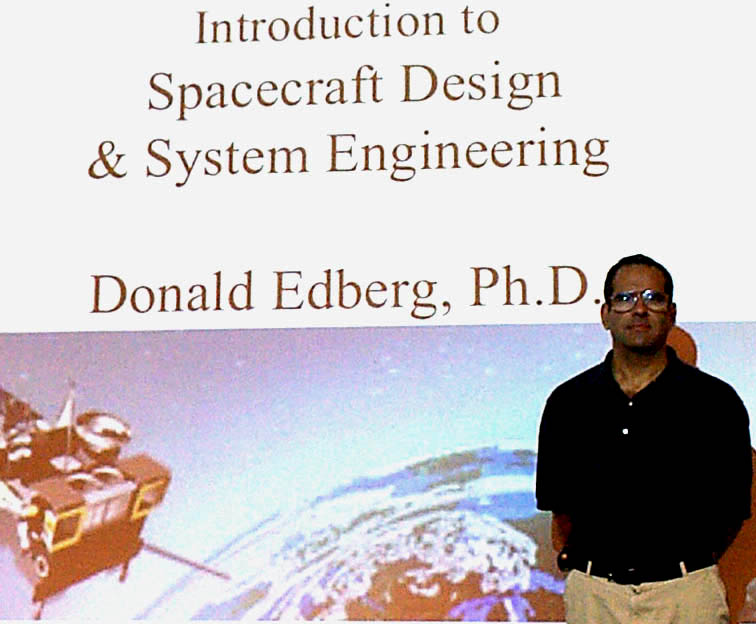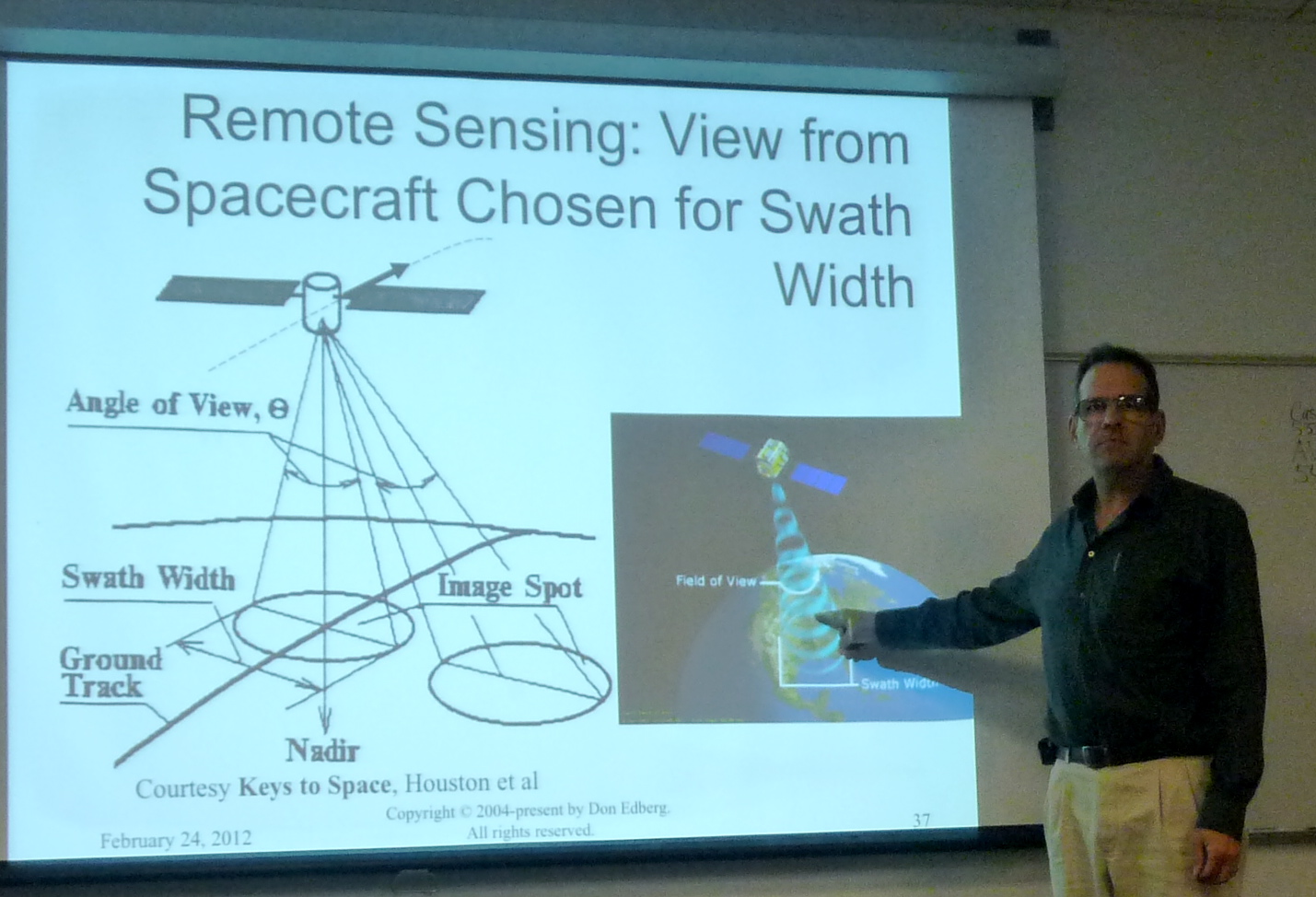Don Edberg's Spacecraft Design & Systems Engineering Class

The lecturer for this class is Donald Edberg, PhD, Professor of Aerospace Engineering, California State Polytechnic University, Pomona, CA. Formerly a Boeing Technical Fellow at Boeing Information, Space, and Defense Systems, Huntington Beach, CA, Dr. Edberg has 20+ years of experience in the aerospace industry and has been employed at General Dynamics, the Jet Propulsion Laboratory, AeroVironment, McDonnell Douglas, and the Boeing Company in addition to his position at Cal Poly Pomona. Dr. Edberg has also taught aircraft, spacecraft, and structural design courses at UCLA, UC San Diego, and UC Irvine, and has consulted for a number of small companies. He teaches full-time at Cal Poly Pomona, and was a Technical Fellow at Boeing’s Phantom Works until June 2009.
During his career, Dr. Edberg has worked on launch vehicle and on-orbit space environments, aerodynamic testing of launch vehicles at high angles of attack, experimental modal and dynamic analysis, smart structures and materials, launch vehicle load mitigation, reduction of on-orbit mechanical vibrations, and microgravity isolation systems as well as the development of an electric-powered, back-packable UAV now in service as the FQM-151 Pointer. Dr. Edberg holds ten U.S. patents in aerospace and related fields and was the inventor of and chief engineer for the patented McDonnell Douglas STABLE (Suppression of Transient Acceleration by Levitation Evaluation) vibration isolation system. STABLE was successfully demonstrated during flight on space shuttle flight STS-73 carrying USML-2 during Oct. 1995. Dr. Edberg is an Associate Fellow of the American Institute of Aeronautics and Astronautics and an active UAV pilot.

Don has put together a comprehensive class on Spacecraft Design and Systems Engineering. The class is offered by UCLA Extension and Taksha University, and can be taken on the UCLA campus or can be presented on-site (over 250 have attended this class, which has been given on 19 separate occasions since 2005 at UCLA, Boeing Satellite Systems, El Segundo, CA, Northrop-Grumman Space Technology, Redondo Beach, CA, Norfolk, VA, and at NASA Langley Research Center, Hampton, Virginia).
This course presents an overview of all the factors that affect the design and operation of satellites and spacecraft. It begins with an historical review of unmanned and manned spacecraft, including current designs and future concepts. All the design drivers, including launch, on-orbit environment, and atmospheric entry are covered, including launch vehicle engineering and its effect on the spacecraft design. Orbital mechanics is presented in a manner that provides an easy understanding of underlying principles as well as applications, such as maneuvering, transfers, rendezvous, and interplanetary transfers. Considerable time is spent defining the systems engineering aspects of spacecraft design, including the spacecraft bus components and the relationship to ground control. Design considerations, such as structures and mechanisms, attitude sensing and control, thermal effects and life support, propulsion systems, power generation, telecommunications, and command and data handling are detailed. Practical aspects, such as fabrication, cost estimation, and testing, also are discussed. The course concludes with several examples of and the lessons learned from spacecraft failures.
This course is ideal for an engineer with a particular specialty, as well as a scientist or instrument specialist, who needs to obtain a solid background in the "big picture" of spacecraft design and how the pieces of the puzzle have to fit together. Managers who want to understand the many aspects of spacecraft design that affect their work, tasks, and scheduling should also benefit from this course. Note that the course may be presented over three contiguous days (see schedule below) or can be presented over six weeknights, each three hours long (Los Angeles area only).
Testimonials:
"This course expanded my general knowledge and broadened my basic
understanding of spacecraft design. It covered and explained areas of design
that I had very limited understanding of." S.R., Engineer Specialist,
Northrop-Grumman Corp.
“I again wanted to say that I really enjoyed your class and
recommended to my management that all of our new hires should take such a
class. It is certainly very useful
to see your own area in the context of the entire space picture.” C.S., Senior Engineering
Specialist, Aerospace Corp.
"This is an excellent course!! Dr. Edberg is an excellent
communicator and has the ability to explain complex terms in an intelligible
manner."
S.Y., Principal Investigator, NASA Langley
"Excellent course for people like me who wish to go into program
management."
M.R., Engineer, Boeing Houston
"This course was great. Instructor was able to simplify but not
talk down to audience. He explained all terms likely not to be
understood."
Anonymous.
"Thanks! This was a great course. I especially liked the launch
vehicle section and some of the communication and CDHS stuff." Anonymous.
"The course was both enjoyable and very thorough. Having the
slides available for additional notes was very helpful. Great course!" Anonymous.
"Would recommend. As a non-technical person some content was
beyond my job scope, but explained well and gives me a reference for
later."
N.P., Contract Administrator, Boeing
"Great lectures. Interesting. Not boring at all. Great notes,
references for further investigation and research." V.B., Engineer, Boeing
Daily Schedule (Three-Day Class format)
Day 1
Spacecraft History
·
The Cold War and
Space Race
·
Early unmanned spacecraft
·
Manned spacecraft
·
Apollo
·
Planetary explorers
·
The future
Spacecraft Design Drivers
Launch Environment
·
Introduction to
ascent trajectories, design drivers, launch vehicle performance
·
Vibroacoustic and thermal environments and load
factors
Space Environment
·
Gravitational
perturbations
·
Aerodynamic drag
·
Gravity gradient
effects
·
Magnetic and solar
effects
·
Outgassing
·
Radiation
Orbital Mechanics
·
Kepler's laws
·
Gravitation
·
Energy and momentum
conservation
·
Conic sections
·
Orbital elements
·
Special orbits
(geostationary, Molniya, sun-synchronous)
Orbital Maneuvers and Rendezvous
·
Orbital transfers,
including Hohmann and fast transfers
·
Plane changes,
patched conics, planetary transfers
·
Low-thrust trajectories,
aerobraking, gravity assists
·
Rendezvous, timing,
Clohessy-Wiltshire equations
Entry Environment
·
Trajectory effects
·
Aerodynamic braking
and heating
·
Deceleration and
loads estimation
·
Shape
·
Thermal protection
Day 2
Systems Engineering
·
Spacecraft missions
and types
·
Engineering design
cycle
·
Payloads
·
Spacecraft bus
elements
·
Launch vehicle
interface
·
Mass and power
estimation
·
Reliability
Structures and Mechanisms
·
Definitions and
methodology
·
General arrangement
and design drivers
·
Constraints,
configuration checklist
·
Structure types,
materials, mechanisms, articulation
Structural Analysis
·
Strength and
stiffness constraints, design load factors, finite-element modeling
·
Dynamics, acoustics,
random vibrations
·
The loads cycle
·
Coupled loads
Attitude Dynamics
·
Three-axis,
momentum-bias, gravity-gradient, spinners, dual-spin spacecraft
·
Spinning, repointing, precession
·
Nutation damping
Attitude Sensing
·
Attitude control
system block diagrams, pointing accuracy, coordinate systems
·
Sensors:
acceleration, angular position and velocity
Attitude Control
·
Thrusters: dual- and
monopropellant, cold gas
·
Reaction wheels,
momentum wheels, control-moment gyros, magnetic torquers
·
Gravity gradient
effects
Thermal Control
·
Heat balance, energy
transfer
·
Passive thermal
control, including coatings, insulation
·
Louvers, shutters,
heaters, cold plates, radioactive heating
Thermal Analysis and Test
·
Radiation
·
Simplified models
·
Finite-element
modeling
·
Thermal-vacuum
testing
Environmental Control & Life Support Systems
·
Water & oxygen
reconditioning
·
Waste management
Day 3
Propulsion
·
Delta-V and the
rocket equation
·
Mass ratios, specific
impulse
·
Propulsion systems,
including solids, mono- and bi-propellant liquids, cold gas, nuclear, ion
propulsion
·
Propulsion system mass
estimation
Power
·
Power system design
procedures
·
Energy sources
·
Solar arrays
·
Batteries: sizing,
life estimation
·
Radioisotope thermal
generators
·
Battery and system
mass estimation
Telecommunications
·
Telemetry, ranging,
ground stations, deep space network
·
Frequency selection,
antennas, data link performance
Command & Data Handling
·
Data encoding &
commutation
·
Functions of
computers and on-board storage
Fabrication and Test
·
Composite structures
·
Testing process,
including vibration, shock, thermal, mechanisms
·
Spacecraft/launch
vehicle integration
Failures and Lessons Learned
·
Case studies
·
Independent checks
Cost Estimation
·
Parametric modeling
·
Cost models
·
ROM costing
·
Launch vehicles
For more information on this
course and how you can have it presented at your facility,
contact Dr. Edberg directly at 909-793-5958,
or send an email to info_AT_dynmodel_DOT_com.